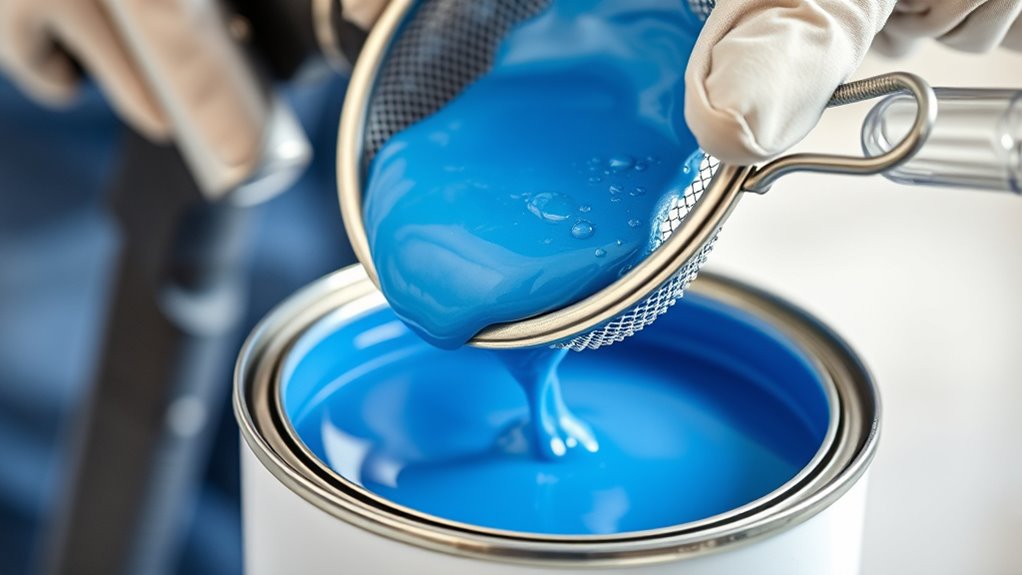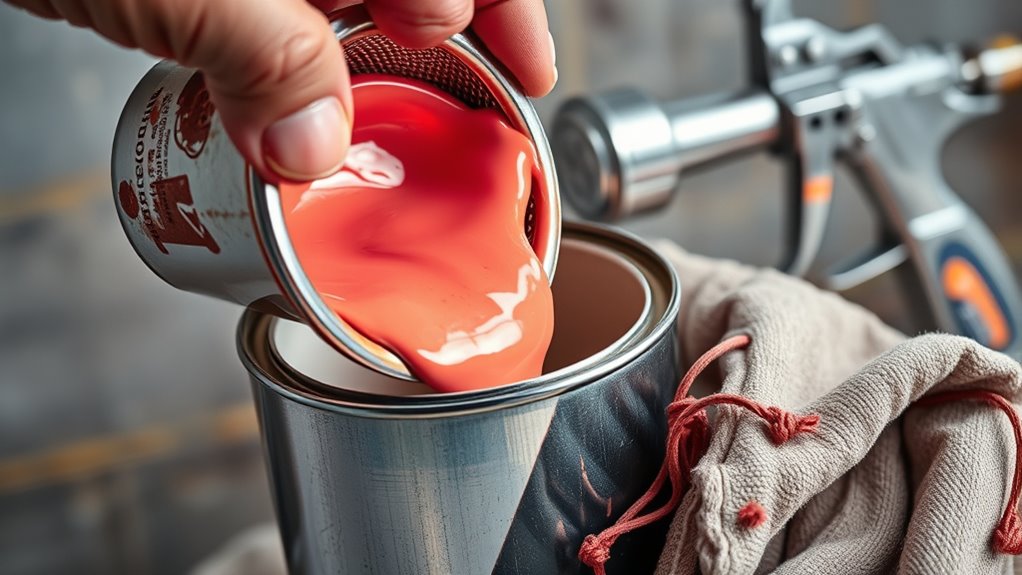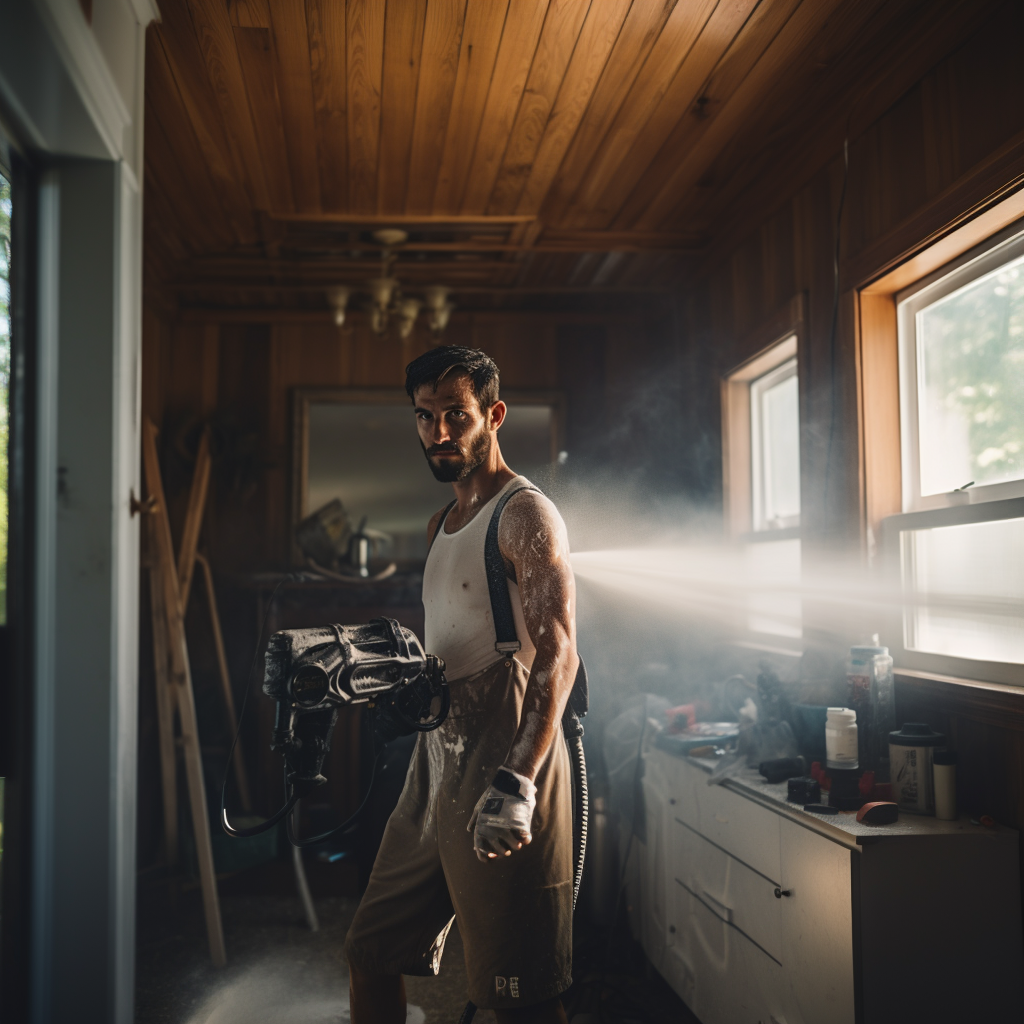Straining paint is vital because it helps remove debris and clumps, ensuring smooth flow and even coverage. It prevents your sprayer from clogging, which can cause delays and damage to your equipment. Regularly filtering paint also reduces strain on your sprayer parts, preventing costly repairs and downtime. Proper maintenance like this keeps your project running smoothly and professional-looking. To discover more tips on maintaining ideal spray quality and equipment care, keep going.
Key Takeaways
- Straining paint ensures debris-free consistency, preventing nozzle clogs and uneven application.
- Properly strained paint reduces strain on sprayer components, lowering repair risks and extending equipment lifespan.
- Filtering paint maintains consistent spray patterns, improving finish quality and avoiding imperfections.
- Regular filter maintenance prevents buildup of dried residue, ensuring optimal flow and reducing operational downtime.
- Using strained paint aligns with industry standards, promoting efficiency, professionalism, and cost-effective results.

Have you ever noticed lumps or debris in your paint? If so, you’re not alone. These unwanted particles can cause serious issues during your painting project, especially when working with sprayers. One of the best ways to prevent this is by properly straining your paint before you start. Straining helps improve the paint consistency, making sure it flows smoothly and evenly from your sprayer. When paint contains debris or clumps, it can clog your equipment, leading to uneven coverage or even damage to the sprayer itself. By taking a few extra minutes to strain your paint, you can avoid these problems and achieve a professional-looking finish. Additionally, understanding how automation in business is transforming industries highlights the importance of maintaining equipment and processes effectively to stay competitive.
Maintaining your filter is just as essential as choosing the right paint. Over time, filters can become clogged with dried paint residue or debris, reducing their effectiveness. When this happens, your sprayer has to work harder to push paint through, which can cause inconsistent spray patterns and increased wear on your equipment. Regular filter maintenance involves cleaning or replacing filters frequently, especially if you notice any change in spray quality or if you’re working with thicker paints. This not only prolongs the lifespan of your sprayer but also ensures that your paint application remains smooth and uniform. Remember, a clean, well-maintained filter plays a pivotal role in maintaining the overall paint consistency, which is necessary for a flawless finish.
Frequently Asked Questions
What Types of Paint Benefit Most From Straining?
You’ll find that thicker paints, like latex or oil-based, benefit most from straining because they often have lumps or debris that can clog your sprayer. Straining helps maintain proper paint consistency, ensuring smooth application techniques. When you strain these paints, you reduce the risk of clogs, drips, and uneven coverage, making your job easier and delivering a professional finish. Always strain thicker paints before starting your project for the best results.
Can I Reuse Paint Through Straining for Multiple Projects?
Reusing paint through straining is like recycling a treasure chest—you’re making the most of what you’ve got. You can definitely reuse paint for multiple projects, but make sure you strain it first to remove debris and extend its life. Proper paint storage is vital to prevent spoilage, and reusing reduces environmental impact by minimizing waste. Just keep an eye on the paint’s consistency and smell to determine if it’s still good to use.
How Fine Should the Paint Be Strained?
You should strain paint until it’s smooth and free of lumps or debris, ensuring the right paint consistency for your project. For best results, strain the paint through a fine mesh filter, typically 100-200 mesh, to catch small particles. You don’t need to strain every time, but do it before each use if you’ve stored the paint for a while. Regular straining minimizes clogs and prolongs your sprayer’s life.
What Tools Are Best for Straining Paint Efficiently?
Did you know that using the right tools can cut your prep time by nearly 30%? For efficient paint straining, you should use a fine filter mesh and straining funnels. The filter mesh captures debris, while the straining funnel makes pouring smooth and mess-free. Together, they prevent clogs and damage to your sprayer, ensuring a professional finish with less hassle. Always choose quality tools for the best results.
Does Straining Paint Affect Its Color Consistency?
Straining paint generally doesn’t affect its color consistency if done properly. It helps improve paint color uniformity by removing debris that could cause uneven pigment distribution. When you strain your paint, you guarantee a smoother, more even application, preventing clogs and drips. Just use the right filter size and work carefully, and you’ll maintain consistent color, achieving a professional-looking finish with balanced pigment distribution throughout your project.
Conclusion
By straining your paint, you prevent clogs and damage to your sprayer, ensuring smooth, even coats. Imagine the difference between a clogged sprayer and one flowing effortlessly, like a clear stream versus a blocked pipe. Don’t let debris turn your project into a struggle; instead, keep your tools running smoothly, like a well-oiled machine. Straining paint isn’t just a step—it’s the difference between frustration and flawless results.
Franz came aboard the Paint Sprayer Zone team with a background in both journalism and home renovation. His articulate writing style, combined with a passion for DIY projects, makes him an invaluable asset. Franz has a knack for breaking down technical jargon into easy-to-understand content, ensuring that even the most novice of readers can grasp the complexities of paint sprayers.










